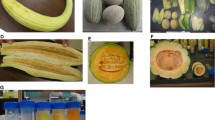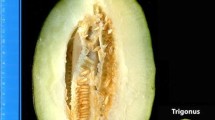Abstract
Melon (Cucumis melo L.) fruit production in U.S. can be improved through the introgression of early fruit maturity (FM) and the enhancement of fruit color [i.e., quantity of β-carotene (QβC); orange mesocarp]. However, the genetics of FM and QβC have not been clearly defined in U.S. Western Shipping market class melons (USWS). Thus, a cross was made between the monoecious, early FM Chinese line ‘Q 3-2-2’ (non-carotene accumulating, white mesocarp) and the andromonecious, comparatively late FM USWS line ‘Top Mark’ (carotene accumulating; orange mesocarp) to determine the inheritance of FM and QβC in melon. Parents and derived cross-progenies (F1, F2, F3, BC1P1, and BC1P2) were evaluated for FM and QβC at Hancock, Wisconsin over 2 years. Estimates of narrow-sense heritability (h 2N ) for QβC and FM as defined by F1, F2, and BC (by individuals) were 0.55 and 0.62, respectively, while estimates based on F3 families were 0.68 and 0.57, respectively for these traits. Mesocarp color segregation (F2 and BC1P2) fit a two gene recessive epistatic model, which in turn, interacts with other minor genes. Although the inheritance of QβC and FM is complex, introgression (e.g., by backcrossing) of early FM genes resident in Chinese germplasm into USWS market types is possible. Such introgression may lead to increased yield potential in USWS market types while retaining relatively high β-carotene fruit content (i.e., orange mesocarp), if stringent, multiple location and early generation family selection (F3–4) is practiced for FM with concomitant selection for QβC.

Similar content being viewed by others
References
Beavis WD (1998) QTL analysis: power, precision and accuracy. In: Paterson AH (ed) Molecular dissection of complex traits. CRC Press, New York, pp 145–162
Bernardo R (2002) Mapping quantitative trait loci. In: Bernardo R (ed) Breeding for quantitative traits in plants. Stemma Press, Woodbury, MN, pp 277–300
Bohn GW, Davis GN (1957) Earliness in F1 hybrid muskmelons and their parent varieties. Hilgardia 26:453–471
Castle WE (1921) An improved method of estimating the number of genetic factors concerned in cases of blending inheritance. Proc Natl Acad Sci USA 81:6904–6907
Clayberg CD (1992) Interaction and linkage test of flesh color genes in Cucumis melo L. Cucurbit Genet Coop Rep 15:53
Cockerham CC (1986) Modification in estimating the number of gene for a quantitative trait character. Genetics 114:659–664
Cuevas HE, Staub JE, Simon PW, Zalapa JE, McCreight JD (2008) Mapping of genetic loci that regulated accumulation of β-carotene in fruit of U.S. Western Shipping melon (Cucumis melo L.). Theor Appl Genet 117:1345–1359
Cuevas HE, Staub JE, Simon PW, Zalapa JE (2009) A consensus linkage map identifies genomic regions controlling fruit maturity and beta-carotene-associated flesh color in melon (Cucumis melo L.). Theor Appl Genet 119:741–756
de Leon N, Coors JG, Kaeppler SM, Rosa GJM (2005) Genetic control of prolificacy and related traits in the golden glow maize population: I phenotypic evaluation. Crop Sci 45:1361–1369
Eduardo I, Fernández-Trujillo JP, Martínez JA, Alarcó AL, Eduardo I, Arús P, Monforte AJ (2008) Identification of melon fruit quality quantitative trait loci using near-isogenic lines. J Am Soc Hort Sci 133:139–151
Falconer DS, Mackay TF (1996) Introduction to quantitative genetics, 4th edn. Longman Group, London, UK
FAO, FAOSTAT Agricultural Database (2004) Food and Agriculture Organization of the United Nations, Rome, Italy, http://faostat.fao.org (accessed on March 2008)
Fukino N, Ohara T, Monforte A, Sugiyama M, Sakata Y, Kunihisa M, Matsumoto S (2008) Identification of QTLs for resistance to powdery mildew and SSR markers diagnostic for powdery mildew resistance genes in melon (Cucumis melo L.). Theor Appl Genet 118:165–175
Giovannucci E (2002) Lycopene and protaste cancer risk. Methodological consideration in the epidemiology literature. Pure Appl Chem 74:1427–1434
Goodnight CJ (1988) Epistasis and the effects of founder events on the additive genetic variance. Evolution 42:441–454
Gross J (1987) Carotenoids. In: Schweigert BS (ed) Pigments in fruits. Academic Press, London, New York, pp 87–186
Hallauer AR, Miranda JB (1988) Quantitative genetics and maize breeding. Iowa State University Press, Ames
Henderson WR, Scott GH, Wehner TC (1998) Interaction of flesh color genes in watermelon. J Hered 89:50–53
Hughes MB (1948) The inheritance of two characters of Cucumis melo and their interrelationship. Proc Amer Soc Hort Sci 52:399–402
Imam MKL, Abo-Bakr MA, Hanna HY (1972) Inheritance of some economic characters in crosses between sweet melon and snake cucumber. I. Inheritance of qualitative characters. Assiut J Ag Sco 3:363–380
IPGRI (2003) Descriptor for melon (Cucumis melo L.). International Plant Genetics Resources Institute, Rome
Jinks JL, Jones RM (1958) Estimation of the components of heterosis. Genetics 43:223–234
Kearsey MJ, Pooni HS (1996) The genetical analysis of quantitative traits, 1st edn. Chapman and Hall, London
Kläui H, Bauernfeind JC (1981) Carotenoids as food colors. In: Bauernfeind JC (ed) Carotenoids as food colorants and vitamin A precursors. Academic Press, New York, pp 48–317
Lande R (1981) The minimum number of genes contributing to quantitative variation between and within populations. Genetic 99:541–543
Lebeda A, Widrlechner MP, Staub J, Ezura H, Zalapa J, Křístová E (2007) Cucurbits (Curcurbitacea; Cucumis ssp., Cucurbita spp., Citrullus spp.). In: Singh RJ (ed) Genetic resources, chromosome engineering, and crop improvement. Chapter 8. CRC Press, Boca Raton, FL
Lester GE, Eischen F (1995) Beta-carotene content of postharvest orange-fleshed muskmelon fruit: Effect of cultivar, growing location and size. Plant Food and Human Nutrition 49:191–197
Lippert LF, Hall MO (1982) Heritabilities and correlation in muskmelon from parent offspring regression analysis. J Am Soc Hort Sci 97:87–90
Luan F, Sheng S, Wang Y, Staub JE (2010) Performance of melon hybrids derived from parents of diverse geographic origin. Euphytica. doi:10.1007/s10681-009-0110-6
Lynch M, Walsh B (1998) Genetic and analysis of quantitative traits. Sinauer association, Inc, Sunderland, MA
Mares-Perlman JA, Millen AE, Ficek TL, Hankinson SE (2002) The body of evidence to support a protective role for lutein and zeaxanthin in delaying chronic disease. J Nutr 132:518S–524S
Mather K, Jinks JL (1982) Biometrical genetics, 3rd edn. Chapman and Hall, London
Monforte AJ, Oliver M, Gonzalo MJ, Alvarez JM, Dolcet-Sanjuan R, Arús P (2004) Identification of quantitative trait loci involved in fruit quality traits in melon (Cucumis melo L.). Theor Appl Genet 108:750–758
N.A.S.S. (2005) USDA economic and statistic system. http://www.nass.usda.gov. Natl. Agr. Stat. Serv. USA
Navazio JP (1994) Utilization of high carotene cucumber germplasm for genetic improvement of nutritional quality. PhD Thesis. University of Wisconsin-Madison
Ng TJ (1990) Generation means analysis by microcomputer. HortScience 25:363
Paris KM, Zalapa JE, McCreight JD, Staub JE (2008) Genetic dissection of fruit quality components in melon (Cucumis melo L.) using a RIL population derived from exotic and elite US Western Shipping germplasm. Mol Breed 22:405–419
Périn C, Hagen LS, Giovinazzo N, Besombes D, Dogimont C, Pitrat M (2002) Genetic control of fruit shape acts prior to anthesis in melon (Cucumis melo L). Mol Genet Genom 266:933–941
Pitrat M (2008) Melon. In: Prohens J, Nuez F (eds) Handbook of plant breeding. Springer, New York, pp 283–315
Royal Horticultural Society (2005) The Royal Horticultural Society Mini Colour Chart. The Royal Horticultural Society, London
Staub JE, Danin-Poleg Y, Fazio G, Horejsi T, Reis N, Katzir N (2000) Comparative analysis of melon (C. melo L.) germplasm using random amplified polymorphic DNA and simple sequence repeat markers. Euphytica 115:225–241
Wright S (1968) Evolution and the genetics of populations. University of Chicago Press, Chicago, IL
Zalapa JE, Staub JE, McCreight JD (2006) Generation means analysis of plant architecture traits and fruit yield in melon. Plant Breed 125:482–487
Zalapa JE, Staub JE, McCreight JD, Chung SM, Cuevas HE (2007) Detection of QTL for yield-related traits using recombinant inbred lines derived from exotic and elite US Western Shipping melon germplasm. Theor Appl Genet 114:1185–1201
Zalapa JE, Staub JE, McCreight JD (2008) Variance component analysis of plant architectural traits and fruit yield in melon. Euphytica 162:129–143
Author information
Authors and Affiliations
Corresponding author
Rights and permissions
About this article
Cite this article
Cuevas, H.E., Staub, J.E. & Simon, P.W. Inheritance of beta-carotene-associated mesocarp color and fruit maturity of melon (Cucumis melo L.). Euphytica 173, 129–140 (2010). https://doi.org/10.1007/s10681-010-0142-y
Received:
Accepted:
Published:
Issue Date:
DOI: https://doi.org/10.1007/s10681-010-0142-y




